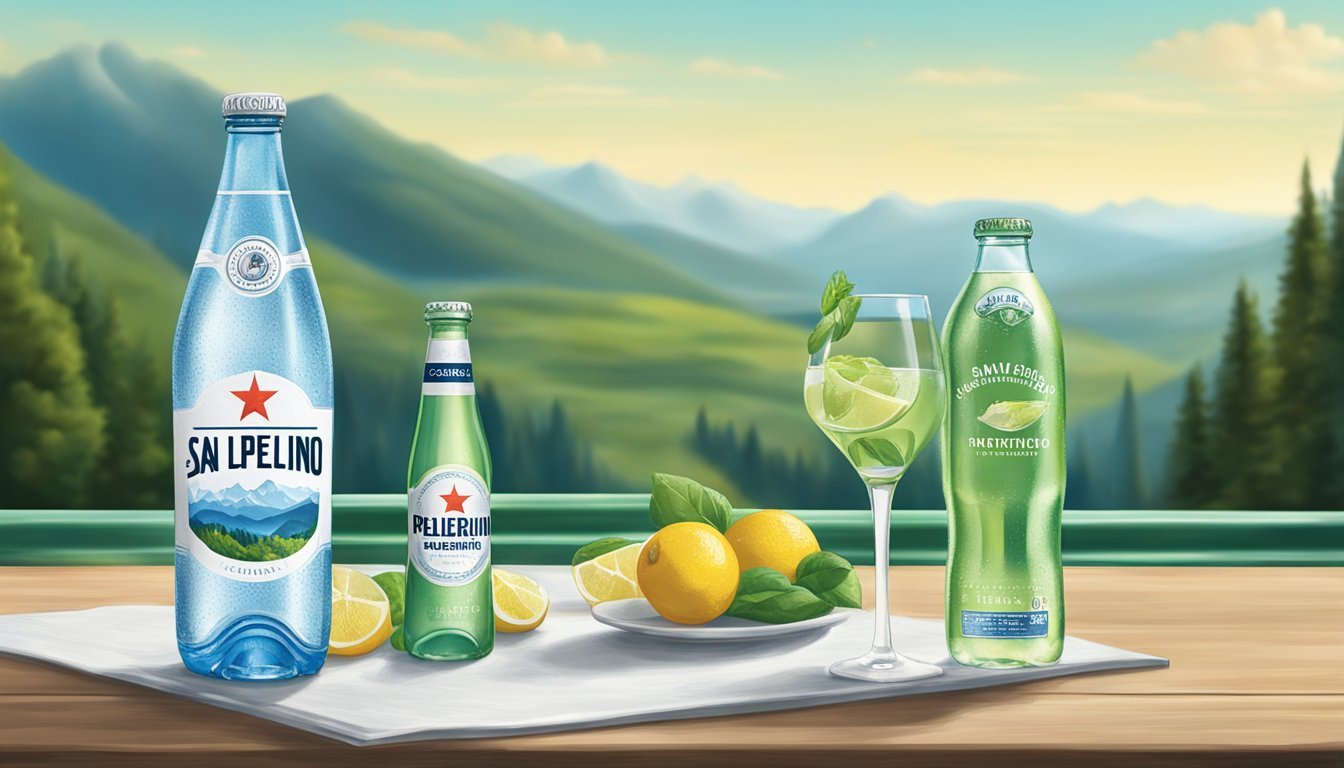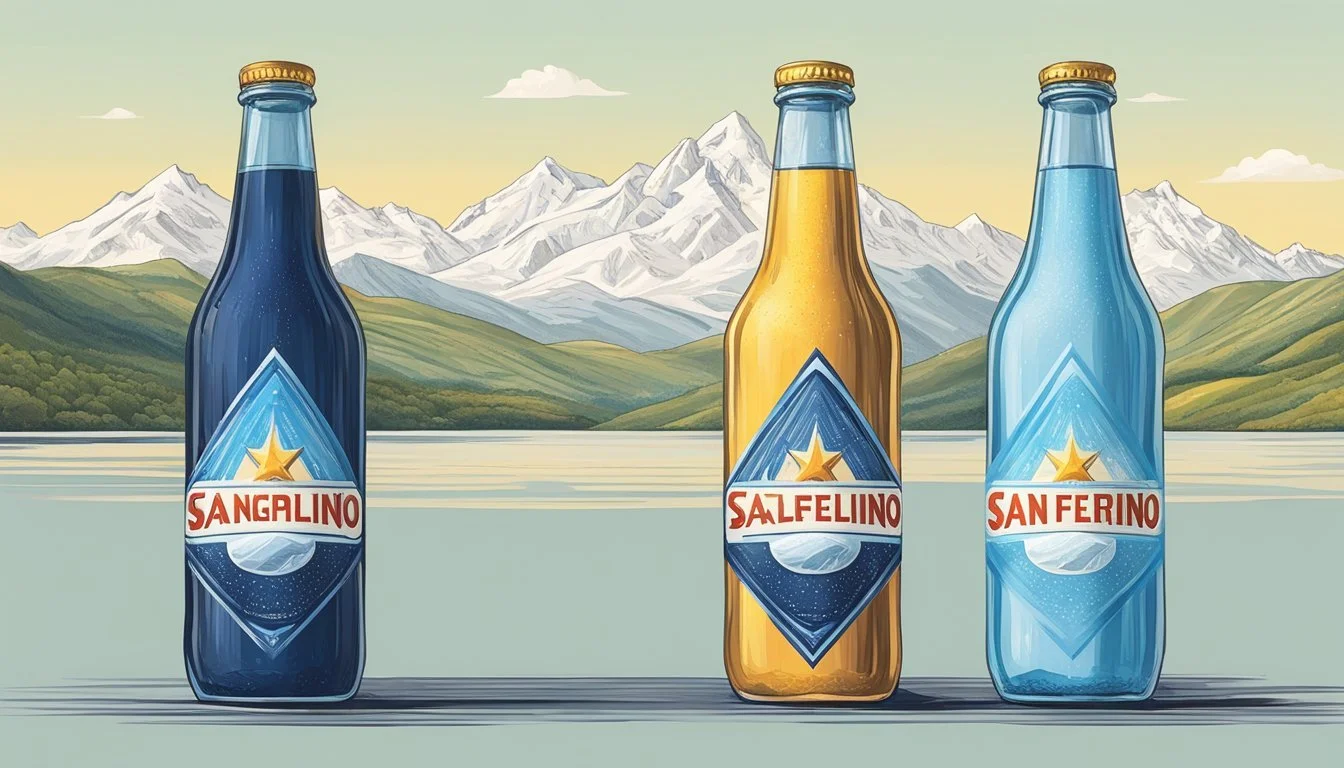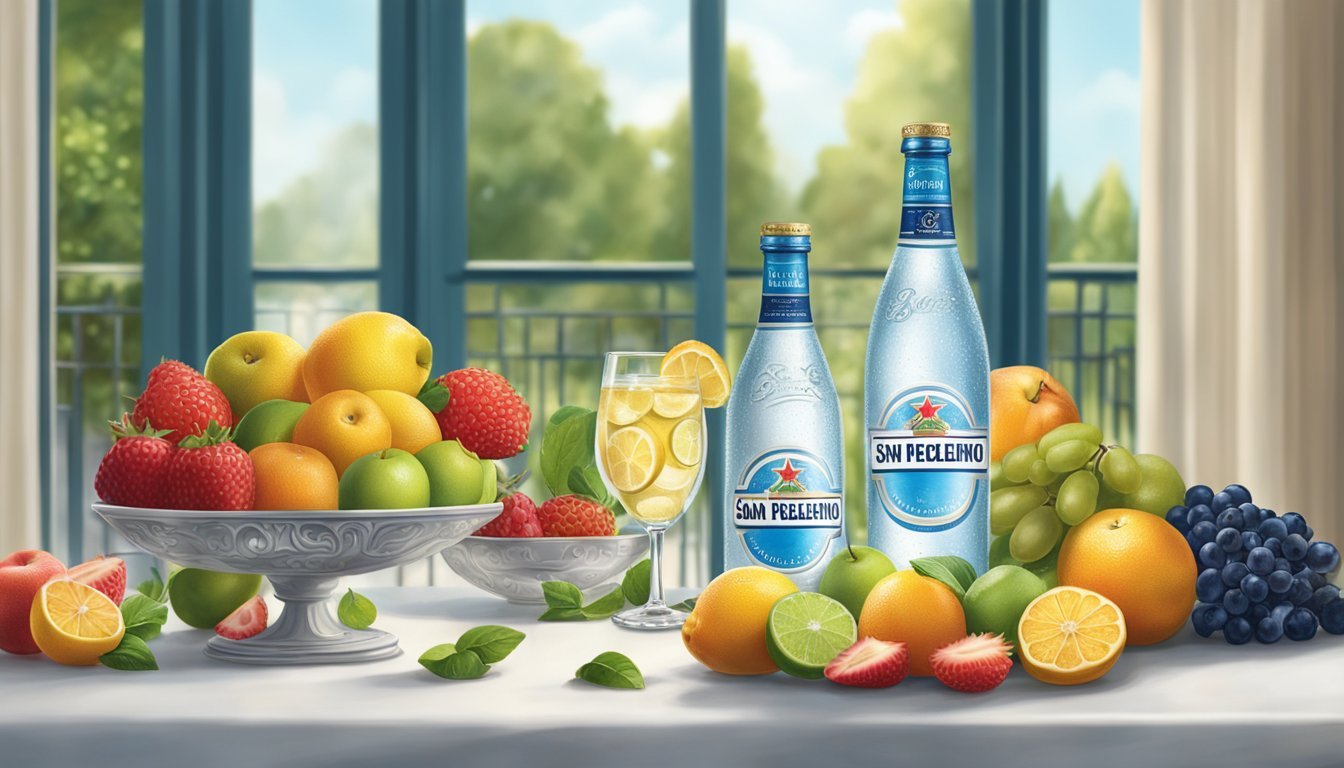Ethos vs. San Pellegrino
Comparing Bottled Water Brands
In the realm of bottled water, consumer preferences vary widely, with some valuing purity and taste, while others prioritize mineral content and health benefits. Ethos Water and San Pellegrino are two brands that have garnered attention, albeit for different reasons. Ethos Water, with its socially responsible promise to help children get access to clean water, goes beyond mere hydration. It has become a popular choice among those who want to make an impact with their purchase. On the other hand, San Pellegrino, known for its naturally carbonated mineral water, has made a name for itself with its signature taste and effervescence, appealing to those who prefer a touch of luxury in their beverages.
While bottled water is seen as a basic commodity, the differences in sourcing, treatment, and branding make each product distinct. Ethos sources its water with an emphasis on ethical practices and charitable contributions, a factor that may resonate with socially conscious consumers. Conversely, San Pellegrino’s sparkling mineral water, sourced from the Lombardy region of Italy, is renowned for its blend of minerals, which are naturally imparted from the rock layers it traverses. This difference in source and content can have implications on the water’s taste, health benefits, and the overall hydration experience.
Choosing between Ethos Water and San Pellegrino is not merely a matter of thirst quenching; it's a decision steeped in personal values, health considerations, and taste preference. Consumers weigh the importance of the social impact and mineral content to decide which brand aligns with their lifestyle. Both brands claim to provide hydration, but the experience they offer goes far beyond the simple act of drinking water.
Overview of Ethos and San Pellegrino
Ethos and San Pellegrino represent two distinct offerings in the bottled water market, differentiated by their origins, water properties, and company histories. The subsequent subsections provide details of their distinct brand journeys, source sustainability, and individual water characteristics.
Brand History and Recognition
Ethos Water began as a social enterprise with a mission to help children gain access to clean water. It was later acquired by Starbucks, leveraging the coffee giant's reach to further its ethical agenda. The brand has gained recognition not just for its water, but for its pledge to contribute a portion of its profits to humanitarian water programs.
San Pellegrino, on the other hand, has a storied history dating back to 1899. Originally sourced from the foothills of the Italian Alps in Bergamo, San Pellegrino is an icon in the world of mineral waters, known for its premium positioning and association with gourmet dining experiences worldwide.
Sources and Sourcing
Ethos: Ethos Water sources its water primarily from private springs, with each bottle reflecting a commitment to ethical sourcing. The brand ensures a portion of its revenue supports water, sanitation, and hygiene education programs in water-stressed countries.
San Pellegrino: The natural spring water of San Pellegrino flows from the Italian Alps, specifically from San Pellegrino Terme in Bergamo. This location provides the water with a unique mineral composition, garnering respect for its quality and sustainability practices.
Water Characteristics
Ethos Water is purified and offers a clean, crisp taste. Its pH level is carefully maintained to ensure a neutral taste, avoiding any significant bias towards acidic or alkaline extremes.
In contrast, San Pellegrino is naturally enriched with calcium, magnesium, and other minerals as it passes through the Alps. It boasts a distinct effervescence and fine bubbles brought on by its natural carbonation process, providing a refreshing and slightly salty taste that has captivated consumers for over a century.
Water Analysis
When comparing bottled waters such as Ethos and San Pellegrino, the key factors to evaluate include mineral content, pH levels, health implications, and the presence of contaminants. These elements contribute to the overall quality and health benefits of the water.
Mineral Content Comparison
Ethos Water:
Sodium: Low
Potassium: Trace amounts
Calcium: Moderate
Magnesium: Trace amounts
San Pellegrino:
Sodium: Moderate to high
Potassium: Moderate
Calcium: High
Magnesium: Moderate
Both brands provide essential minerals, but San Pellegrino typically contains higher levels of calcium and magnesium which are beneficial for bone and heart health.
pH Levels and Acidity
Ethos Water: pH close to neutral (approximately pH 7)
San Pellegrino: Slightly acidic (pH between 4.2 and 5.5)
Alkaline water, such as Ethos with a neutral pH, may support better hydration and aid in digestive health. In contrast, San Pellegrino's lower pH indicates a more acidic nature, which might not be optimal for those seeking to minimize acidity in their diet.
Health Implications
Consumption of water with balanced mineral content is crucial for maintaining hydration and supporting bodily functions. Ethos, being neutral in pH, may be gentler on the digestion, while San Pellegrino's effervescence can aid in digestion due to its carbonation. High mineral content in San Pellegrino supports bone and cardiovascular health, though its acidity should be considered.
Presence of Contaminants
Both Ethos and San Pellegrino adhere to the guidelines set by the Environmental Protection Agency (EPA), ensuring their water is free from harmful levels of contaminants. Neither brand is known to contain PFAS chemicals. They are both frequently tested to maintain high standards of purity.
Taste Profiles and Culinary Uses
When comparing Ethos and San Pellegrino bottled waters, discerning consumers and culinary experts pay close attention to the taste profiles and their applicability in food and beverage pairings. This section breaks down their unique characteristics.
Flavor Experience
Ethos Water comes across as neutral and clean, making it a choice for those seeking a straightforward, unadorned drink. Without a strong mineral taste, it doesn't overwhelm the palate and is often the preferred choice for hydration on its own.
San Pellegrino, in contrast, is recognized for its light fizz and distinct minerality, attributes that stem from its origins in the Italian Alps. The carbonation in San Pellegrino is pronounced, providing a pleasurable tingling sensation that complements its earthy taste profile. The fizziness enhances the overall drinking experience, often described as refreshing.
Pairings with Food
Ethos Water:
Best with light fares such as salads and delicate fish dishes due to its purity and lack of competing flavors.
Its neutral profile means it does not interact significantly with the flavors of the food.
San Pellegrino:
The preferred choice for sommeliers and restaurants, as its fizz and minerality can hold up against richer and more flavorful dishes.
Commonly paired with both food and wine, especially with Italian cuisine, enhancing the flavors and cleansing the palate between bites.
Mixing with Other Beverages
Ethos Water is a suitable base for cocktails and other mixed beverages due to its neutral taste, allowing the flavors of the spirits and mixers to shine through.
Conversely, San Pellegrino is often utilized in mixology for cocktails that benefit from a touch of carbonation and a subtle mineral undertone. San Pellegrino can elevate a drink, giving it a more complex flavor profile that both cocktail aficionados and casual drinkers appreciate.
Environmental Impact
The environmental impact of bottled water brands like Ethos and San Pellegrino is significant, particularly due to their bottling, packaging, and the associated carbon footprint.
Bottling and Packaging
Ethos Water, a subsidiary of Starbucks, is known for its philanthropic efforts in water accessibility, yet it typically utilizes plastic bottles. These plastic bottles are a major contributor to waste and pollution, compounded by the drought conditions in places like California where water resources are already stretched thin. Ethos Water claims to provide portions of its proceeds to water replenishment and community support, but the environmental cost of plastic bottles remains a concern.
In contrast, San Pellegrino often opts for glass bottles, which carry a different environmental profile. Glass packaging is heavier and more energy-intensive to transport but can be recycled indefinitely without losing integrity. The impact of glass bottle production and recycling on ecosystems still warrants consideration, as it also consumes resources and generates carbon dioxide but less so than their plastic counterparts when recycled properly.
Carbon Footprint
The carbon footprint of bottled water production encompasses the lifecycle of the product, from extraction to transportation. For both Ethos and San Pellegrino, transportation is a key factor, as both brands are distributed globally. Transportation of bottled water, especially overseas, results in higher outputs of carbon dioxide, contributing to their environmental impact.
Ethos Water, sourced in the United States, can benefit from shorter domestic transport routes, potentially lessening its carbon footprint within the U.S. However, the international distribution of both Ethos and San Pellegrino notably increases their global carbon footprints. San Pellegrino's source and bottling location in Italy means it must be transported vast distances to reach international markets, including the U.S., further increasing its carbon emissions.
Both companies must contend with the environmental implications of their production and distribution practices, as the bottled water industry faces growing scrutiny over its sustainability.
Consumer Information
In this section, consumers can find detailed insights into the labeling, certifications, and financial considerations of Ethos and San Pellegrino bottled waters.
Label Transparency
Ethos Water prides itself on clarity regarding its source and contents. Each bottle's label indicates that Ethos water is purified and includes added minerals for taste. On the other hand, San Pellegrino labels highlight its heritage, indicating that the water is naturally carbonated with minerals from the springs of the Italian Alps.
Ethos Water: Minerals added for flavor, source: varies; purified water
San Pellegrino: Naturally occurring minerals, source: San Pellegrino Terme (Italy); natural carbonation
Certifications and Standards
San Pellegrino water meets high safety standards and reports that it is non-GMO and gluten-free, which are preferences for some consumers. Ethos Water, while also aiming for quality, is part of a social initiative where sales contribute to global humanitarian water programs.
Ethos Water: No specific certifications advertised
San Pellegrino: Non-GMO, gluten-free endorsements
Price Comparison and Value
When it comes to price, Ethos Water is generally seen as budget-friendly, marketing itself as an affordable premium water. San Pellegrino is usually priced higher due to its perceived premium quality and naturally carbonated mineral water.
Brand Price Range Size Notes Ethos Water Lower price range 500ml/1L Budget-friendly San Pellegrino Higher price range 250ml/750ml Premium quality
The value for each brand comes down to consumer preference—whether one favors Ethos Water's social initiative and lower cost or San Pellegrino's unique mineral composition and taste profile.
Competitive Landscape
In the bottled water industry, competition is intense with numerous players vying for consumer attention through distinct brand identities and product offerings.
Market Alternatives
The bottled water market is saturated with alternatives ranging from Perrier and La Croix to Evian and VOSS. Each product brings something different to the table, whether it's Perrier's French heritage in sparkling mineral water or La Croix's variety of flavored seltzer waters. Topo Chico has made a name for itself with a strong mineral taste profile, while the Italian classic San Pellegrino remains a staple in the sparkling mineral water segment. On the other hand, Bubly Sparkling Water and Hal's are newer entrants offering both plain and flavored seltzer options, competing directly with club sodas and other seltzers in the market.
Brand Differentiation
Brands differentiate themselves through origin, such as Evian's French Alps source, or through branding, such as the upscale positioning of VOSS. San Pellegrino is noted for its Italian origin and has long been associated with fine dining, thanks to its moderate fizz and signature taste. In contrast, Ethos Water emphasizes its ethical commitment; every bottle sold includes a contribution to humanitarian water programs. Perrier has positioned itself uniquely with bold, naturally flavored options and a distinct green bottle, while La Croix plays on a variety of flavors and a vibrant design to appeal to health-conscious consumers.
Consumer Preferences
Consumers' preferences in the bottled water market vary widely, with choices often influenced by taste, brand perception, and individual values. Some consumers prefer the subtle carbonation and mineral content of Italian sparkling mineral waters like San Pellegrino, while others might opt for the intense bubbles of club soda for a refreshing alternative. The taste profiles of French mineral waters such as Evian are preferred by those who favor a smooth, clean taste without carbonation. Health-conscious individuals may gravitate toward brands like La Croix and Bubly, which offer no artificial sweeteners or calories and come in an array of flavors. Environmental values also come into play, as some consumers seek out brands like Ethos Water based on their social contribution.
Future Trends in Bottled Water
The bottled water market is evolving rapidly with technological innovations, changing consumer preferences, and a growing emphasis on health and wellness. These factors shape the industry's future, influencing production methods and product offerings.
Innovations in Water Production
Manufacturers are increasingly adopting reverse osmosis to purify water, which may see further advancements in efficiency and sustainability. This process, combined with additional filtration methods, ensures high purity and is often used by brands like Essentia to produce alkaline water.
Shifting Consumer Tastes
Sparkling water brands are expanding their portfolios to include a wider range of flavored sparkling waters. Popular flavors like lime, lemon, and cucumber cater to a growing desire for healthier alternatives to sugary beverages. As consumer palates evolve, one can expect a broader variety of natural flavors and an increase in artisanal and craft water offerings.
Health and Wellness Influence
Health-conscious consumers are steering the bottled water industry towards products like alkaline water, which boasts benefits such as better hydration. In response, companies are focusing on delivering not just clean water, but also enhanced products that support overall wellness. The popularity of functional waters is on the rise, driven by a consumer base that values added health benefits.
Conclusion
When comparing Ethos and San Pellegrino bottled waters, consumers primarily consider hydration, mineral content, taste, and health benefits. Both brands serve the fundamental purpose of hydration effectively. However, their mineral content and taste profiles cater to different preferences and needs.
Ethos Water, a brand with a charitable angle, provides clean water with a straightforward taste. It's commonly found in Starbucks cafes, aligning with casual consumption. The brand's contribution to water access initiatives adds a positive social impact to each purchase.
In contrast, San Pellegrino is a sparkling mineral water known for its distinctive taste due to its rich mineral content. Originating from Italy, a sip of San Pellegrino brings effervescence, a moderately salty flavor, and a touch of sophistication, often associated with dining experiences.
Here is a brief comparison:
Ethos Water San Pellegrino Type Still Sparkling Taste Neutral Saline, bubbly Mineral Content Lower Higher Health Impact Hydration Hydration, May aid digestion Social Impact Charitable contributions Limited
Ultimately, the choice between Ethos and San Pellegrino should be based on personal taste preferences and desired social impact. Individuals seeking classic still water for hydration and charitable impact may lean towards Ethos. Conversely, those looking for a distinct, mineral-rich taste with the refreshing quality of carbonation may prefer San Pellegrino. Both brands offer a safe and healthy bottled water option with unique benefits.







